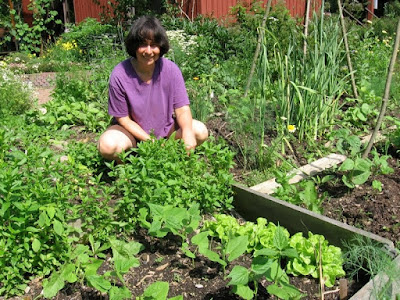
Wild cherry, or Prunis avium ("bird cherry")
An avian frenzy earlier this week alerted me that the wild cherries growing not far from our deck were ripening. Since then, there has been a continuous parade of birds from early morning through dusk, and, seemingly, an equally continuous conversation as word spreads through the tree tops. Not surprising then, that the latin name for the tree, Prunis avium, translates as "bird cherry." However, the birds are not alone in their feasting. Grey and red squirrels scamper through the branches seeking their share, in their haste, knocking to the ground almost as many cherries as they eat. Last night, around 9:30 pm, an unusual rustling in the garden drew me out to investigate. About two-thirds of the way up one of the 50 foot cherry trees was a dark, furry shape, slightly bigger than a large cat. It was difficult to be sure in the fading light, but it appeared to be a possum getting in on the feast. Or perhaps a raccoon.

The Goumi berries are more within our reach
We hate to miss out, but have had to be satisfied with the handful of burgendy jewels Richard has pulled down with last summer’s invention – a very long pole to which he has taped a large fork. (No tree-climbing exploits for him this year.) On the other hand, we do have the strawberries, which are planted as a border along many of the perennial flower beds, and the goumi berries, which in their first full year are yielding a handful a day of scarlet-red, tart fruit.

A handful of goumi berries
Native to the Russian Far East, China and Japan, the tart but tasty goumis are a bit like pie cherries. Given the rapid growth of these shrubs, we will likely have 3-4 times that amount next year. So far, the birds have left them alone – because they are occupied by the cherries, or haven’t yet discovered this non-native fruit, or the still-small shrubs are too close to the ground (and our cats), I can’t say.

Woodland strawberries
This has also been a bumper year for the tiny woodland strawberry. Some opportune combination of rain, warm weather and, perhaps, Richard’s efforts to thin out the woods where they grow as groundcover. While it would take a lot of work to find and pick enough to fill a bowl, they are wonderful to nibble, with a flavor that is more “strawberry” than any of the domestic varieties bred for their larger fruit. Tidbit from Wikipedia: "Evidence from archaeological excavations suggests that Fragaria vesca has been consumed by humans since the Stone Age. The woodland strawberry was first cultivated in ancient Persia where farmers knew the fruit as Toot Farangi. Its seeds were later taken along the silk road towards the far East and to Europe it was widely cultivated until the 18th century, when it began to be replaced by the garden strawberry."
 Snow peas are at their peak.
Snow peas are at their peak. As for vegetables: mid-June, we are finally nearing the end of our overwintered and early-start greens; the last of that kale, mustard greens, and Asian stir-fry greens will probably be eaten by next weekend. But the snow peas – planted in mid-March, the day after I impatiently cleared the deep, insulating snow from one of the beds – are at their peak, and the sugar snap peas are not far behind. We’re harvesting the early carrots, beets and turnips as well.
The chard awaits. The cabbages are filling out...
.. the squash, beans and corn are up...
... and while weeding among mint, I startled a leopard frog, perhaps the same one I wrote about last summer. I was happy to find it, in part for its help on pest-patrol and in part, because it is an “indicator species” whose presence speaks to the health of its habitat. Once common, leopard frogs began declining in the 1970s and have not yet recovered.

Finally, out by the garlic and potato beds, the species roses are blooming. Simpler in form than the hybrid tea roses, they are far more fragrant and far, far less fussy, not prone to pest or disease and requiring little tending. They yield very large rose hips, which we'll harvest later in the summer for winter teas. They also remind me to stop weeding and smell the roses.














